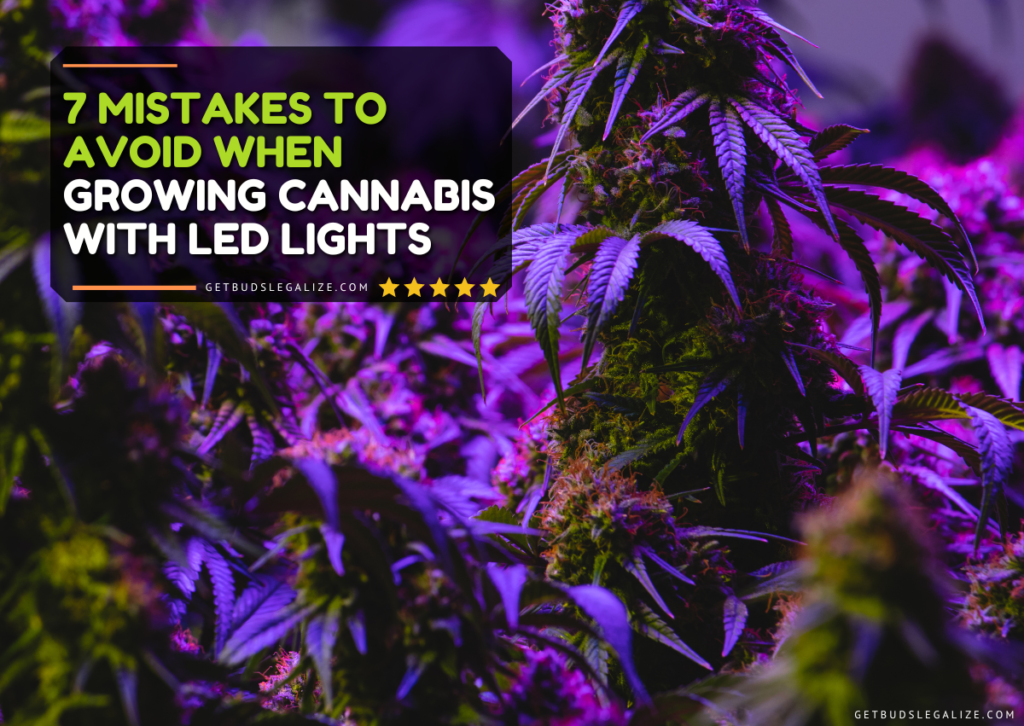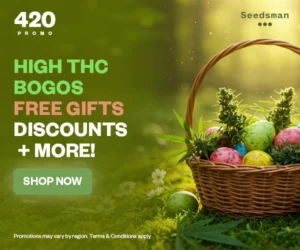7 Mistakes to Avoid when Growing Cannabis with LED Lights
Growing cannabis with LED lights can be a rewarding and cost-effective way to produce high-quality buds. LED are energy-efficient, long-lasting, and easy to use.
However, they also come with some challenges and pitfalls that you need to avoid if you want to get the best results from your indoor growth. Here are seven common mistakes you should avoid when growing cannabis with these lights.
1. Placing the LED Lights Too Close or Too Far from Your Plants
One of the most critical factors that affect the growth and health of your cannabis plants is the distance between the lights and the plant canopy. If the lights are too close, you risk burning or bleaching your plants, which can reduce their yield and quality. If the lights are too far, you waste electricity and reduce the light intensity and coverage, which can result in stretching weak stems, and airy buds.
The optimal distance between your LED grow lights and your plants depends on several factors, such as the wattage, the spectrum, the size and shape of your grow space, and the stage of growth of your plants. However, as a guideline, you can follow the table below:
- 1w LED: 30-32cm from the top of the plants
- 5w LED: 41-45cm from the top of the plants
- 300+w LED: 75cm or more from the top of the plants
These distances are approximate and may vary depending on your specific setup and strain. To find the ideal distance, you can use a light meter to measure the photosynthetically active radiation (PAR) levels at different points in your growing space.
PAR is a measure of the amount of light that is usable by plants for photosynthesis. The optimal PAR range for cannabis plants is between 400 and 800 micromoles per square meter per second (µmol/m²/s). You can adjust the height of your LED lights until you achieve this range at the canopy level.
Another way to determine the proper distance for your lights is to observe your plants’ response. If you see signs of light stress, such as curling or yellowing leaves, brown spots, or bleached buds, you need to move your lights further away. If you see signs of light deficiency, such as stretching, weak stems, or small buds, you need to move your lights closer.
You should also adjust the distance of your lights according to the stage of growth of your plants. During the vegetative stage, you can keep your lights closer to encourage bushy and compact growth. During the flowering stage, you can raise your lights slightly to increase the light coverage and penetration.
2. Not Providing Your Plants with The Right Amount of Light
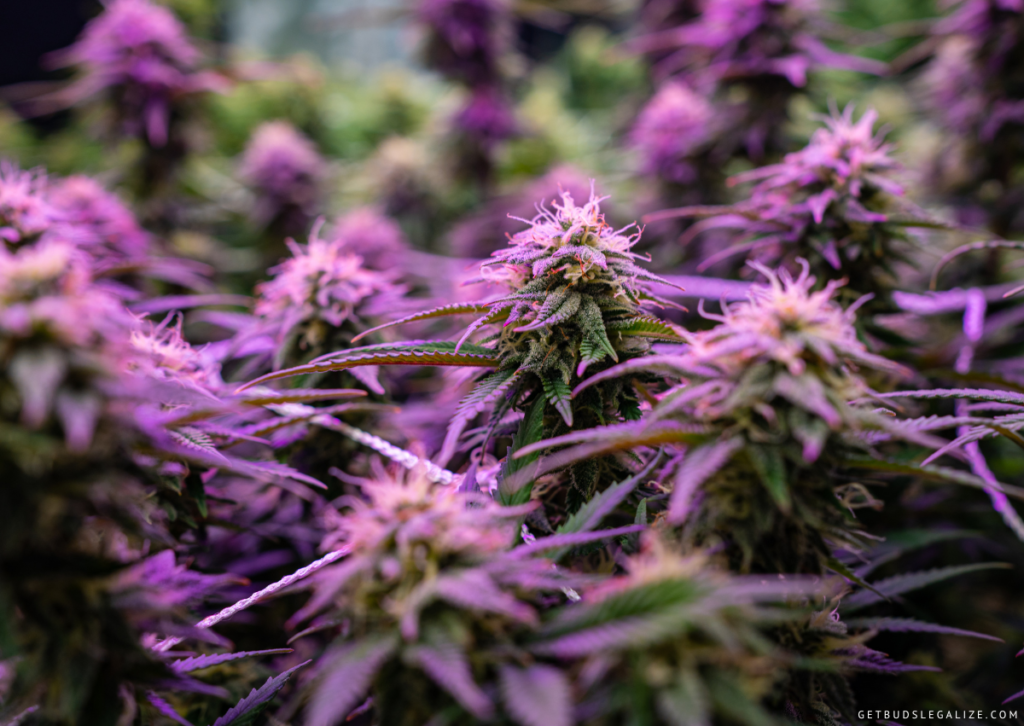
Another common mistake that cannabis growers make when using LED lighting is not providing their plants with enough light. Cannabis needs a lot of light to grow and produce buds, especially during flowering. If they don’t receive enough light, they will grow slowly, produce tiny and airy buds, and have low THC levels.
The amount of light that your plants need depends on several factors, such as the size of your grow room, the number of plants, the strain, and the stage of growth. A general rule of thumb is to provide at least 30-40 watts of actual power per square foot of grow space for LED lights.
However, you should always check the manufacturer’s specifications for your specific lights, as well as monitor your plants for signs of light deficiency. You can also use a lux meter or a PAR meter to measure the light output and compare it to the optimal range for cannabis.
3. Overwatering
Overwatering is one of the most common mistakes that growers make when growing weed with any type of lighting system, but it can be especially problematic when using LED grow lights.
LED produce less heat than other types of lights, which means that they don’t evaporate as much water from the soil and the plant leaves. This can lead to overwatering, which is a condition where the soil becomes too wet and soggy, preventing oxygen from reaching the roots. Overwatering can cause root rot, nutrient lockout, mold, fungus gnats, and other issues that can harm your cannabis plants.
The best way to avoid overwatering your plants is to water them only when they need it. You can tell if your plants need water by checking the weight of the pots, lifting them, and feeling how heavy they are. You can also check the moisture level of the soil by sticking your finger into it up to the second knuckle. If you feel the soil is dry, it’s time to water. If it feels moist or wet, wait until it dries out more. You should also use pots with drainage holes and a well-aerated soil mix that allows excess water to drain out easily.
4. Providing an Improper Light Schedule
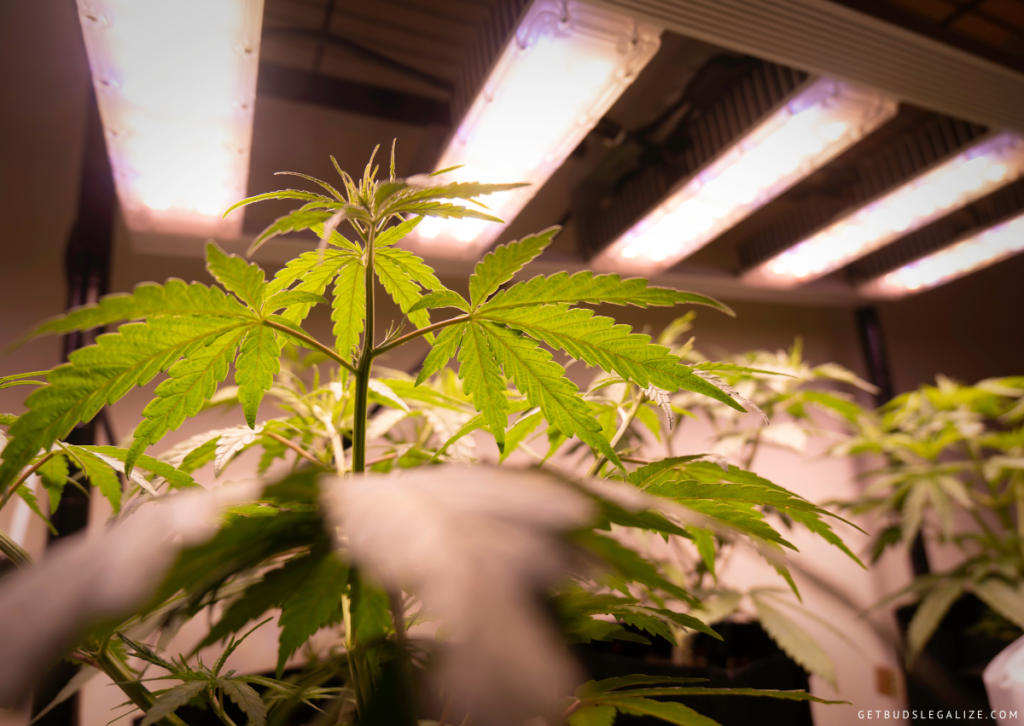
Another mistake that growers make when using LED grow lights is providing an improper light schedule for their cannabis plants. Cannabis plants have different light requirements depending on their stage of growth and their photoperiod (the number of hours of light and darkness they receive).
Cannabis plants that are in the vegetative stage need at least 18 hours of light and 6 hours of darkness per day to grow healthy and strong. Plants that are in the flowering stage need 12 hours of light and 12 hours of darkness per day to trigger their flowering hormones and produce buds.
The best way to provide a proper light schedule for your indoor cannabis is to use a timer that automatically turns your LED grow lights on and off according to your desired photoperiod.
You should also make sure that your grow space is completely dark during the dark period, as any light leaks can disrupt your plants’ flowering cycle and cause them to revert to vegetative growth or become hermaphrodites (plants that produce both male and female flowers).
5. Choosing The Wrong Type of LED Light
Another mistake that growers make when using LED grow lights is choosing the wrong type of light for their plants. LED lights come in different types, such as full spectrum, white, red, blue, and purple.
Each type of grow light has a different color temperature, which is measured in Kelvin (K). The color temperature of light affects the spectrum of light that it emits, which in turn affects the growth and development of your cannabis plants.
The best type of LED grow light for your marijuana plants depends on your preference, budget, and goals. However, a general rule of thumb is to choose a full spectrum light or a white LED light that has a color temperature of around 3000K to 4000K. These types of LED lights provide a balanced spectrum of light that mimics the natural sunlight and covers all the essential wavelengths that your cannabis plants need for photosynthesis and flowering.
You can also supplement your main light with some red or blue LED to enhance certain aspects of your plant’s growth, such as stem strength, leaf size, bud density, and resin production.
6. Choosing Low-Quality LED Lights
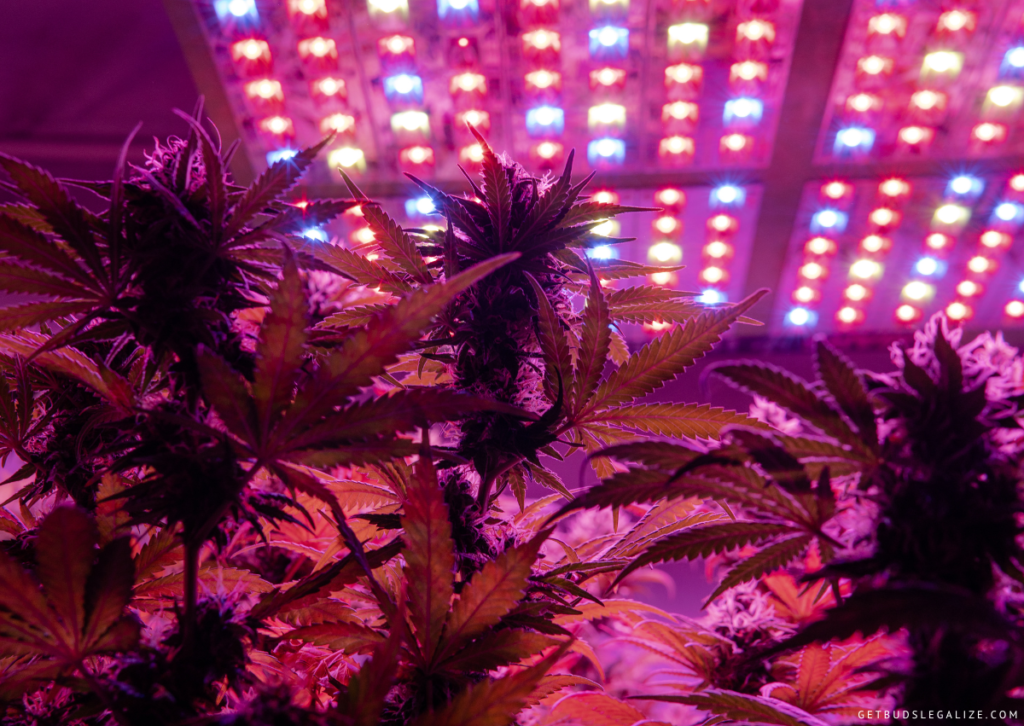
Another mistake that marijuana growers make when using LED grow lights is choosing low-quality lights that are cheap and unreliable. Low-quality lights can have several drawbacks, such as low light output, poor spectrum, short lifespan, high heat output, and high electricity consumption. These drawbacks can negatively affect the growth and yield of your cannabis plants, as well as increase your costs and risks.
The best way to avoid choosing the wrong one is to do your research and compare different brands and models of lights before buying them. You should look for lights that have high-quality components, such as high-power LEDs, drivers, fans, heat sinks, and lenses.
You should also look for lights that have good reviews and ratings from other growers who have used them. You should also check the warranty and customer service of the manufacturer or seller, in case you encounter any issues or defects with your lights.
7. Not Adjusting the Nutrients and pH Levels
The last mistake that growers make when using LED lights is not adjusting their nutrients and pH levels according to their lighting system. Using LED can affect the nutrient uptake and pH balance of your cannabis plants, as they can alter the rate of photosynthesis and transpiration. If you don’t adjust your nutrients and pH levels accordingly, you can cause nutrient deficiencies or toxicities, as well as pH fluctuations, which can harm your cannabis plants.
The best way to adjust your nutrients and pH levels is to monitor your plants closely and test your soil or water regularly. You should use a nutrient solution that is designed for cannabis plants and follow the manufacturer’s instructions for mixing and feeding.
You should also use a pH meter or pH strips to measure the pH level of your soil or water and adjust it with pH up or pH down products if needed. The optimal pH level for cannabis is between 6.0 and 7.0 for soil and between 5.5 and 6.5 for hydroponics.
Are You Ready Now to Try LED Lights on Your Cannabis Cultivation?
Growing cannabis with LED lights can be a rewarding and cost-effective way to produce high-quality buds. However, you also need to be careful and avoid some common mistakes growers make when using this light system, such as choosing the wrong light spectrum, placing the lights too close or too far from the plants, and not adjusting the cycle or intensity of the light according to the needs of the plant, etc.
By following these tips and guidelines, you can avoid these mistakes and get the best results from your cannabis growing. Happy growing!
FAQs about growing cannabis with led lights
The wattage of grow lights that you need for your grow tent depends on the size of your grow space, the number of plants that you have, and the type of LED lights that you use. A general guideline is to use 30 to 50 watts per square foot of grow space for most LED lights.
However, this may vary depending on the efficiency and quality of your LED lights. You can use a wattage calculator to estimate how many watts of LED lights you need for your growing space.
The duration of light that you should give your plants depends on the stage of growth that they are in. During the vegetative, you should give your plants 18 to 24 hours of light per day.
During the flowering stage, you should switch to 12 hours of light and 12 hours of darkness per day. You can use a timer to automate the light cycle for your plants.
The best way to know if your plants are getting enough light from your cannabis lights is to monitor their growth and development. If your plants are healthy and vigorous, with dark green leaves and strong stems, then they are getting enough light from your LED lights.
If your plants are weak and spindly, with pale leaves and thin stems, then they are not getting enough light from your LED lights. You can also use a light meter to measure the intensity of the light (PPFD) at different points in your growing space.
The best LED lights to choose to grow cannabis depend on several factors, such as the size of your grow space, the number of plants that you have, the type of plants that you grow, and your budget.
You want to choose cannabis grow lights that have a high-quality build, a full spectrum of light, a high light intensity (PPFD), a good coverage area, a long lifespan, a low heat output, a low power consumption, and a good warranty. You can compare different models and brands online or in stores to find the best one for your needs
There are many types of grow lights available in the market but some of the most popular ones are spider farmer and mars hydro. These lights have different pros and cons, depending on your budget, space, and goals.
Spider-farmer lights are a brand of full spectrum LED lights that use Samsung LM301B diodes and Mean Well drivers. They have a high light output and efficiency, as well as a dimmable function and a waterproof design. Spider-farmer lights are affordable, reliable, and easy to install. However, they may not have enough cooling fans and may produce some noise.
Mars-hydro lights are another brand that uses Epistar chips and Mean Well drivers. They have a high light output and efficiency, as well as a daisy chain function and a detachable design. Mars-hydro lights are cheap, durable, and flexible. However, they may not have enough heat dissipation and may cause some light leakage.
Both have their pros and cons, but in general, cannabis LED lights are more efficient, cost-effective, and versatile than HPS/MHL lights. Here are some reasons why:
- LED consume less electricity than HPS/MHL lights, which means lower energy bills and less heat generation. According to one source, LED lights can yield on average 2x more at a given wattage than HPS/MHL lights.
- LED have a longer lifespan than HPS/MHL lights, which means less maintenance and replacement costs. HPS/MHL bulbs need to be changed every 6 to 12 months, while LED lights can last for years.
- LED can produce a full spectrum of light that can be customized to suit different stages of plant growth. HPS/MHL lights have a limited spectrum that is mostly in the red and yellow range, which is good for flowering but not for vegetative growth.
- LED can increase cannabis quality compared to metal halide lights, which can produce harsh and airy buds. LED lights can enhance the flavor, aroma, potency, and resin production of cannabis buds by providing optimal intensity of light and spectrum.
ILGM Fertilizer

- From seedling to harvest, give your plants everything they need.
- Enough for feeding at least 5 plants.
- Discounted Package Deal
- Works well in soil, hydroponics, and other growing mediums.
- The best way to treat your plants
ILGM Plant Protector

- Protect your cannabis from diseases and harmful pests.
- Contains three 20 ml bottles.
- Enough supplies to protect 20 plants.
- It can be used in soil, hydroponic, and all other growing mediums.

